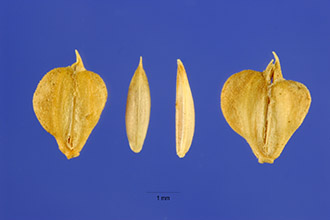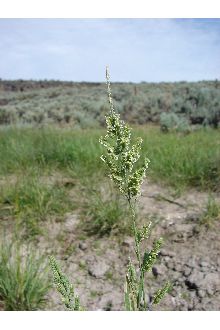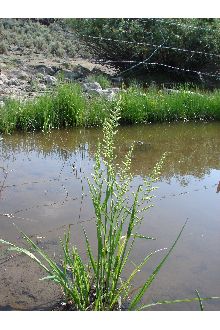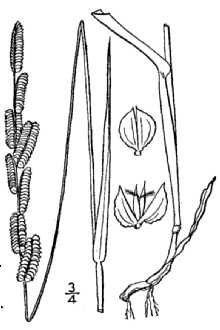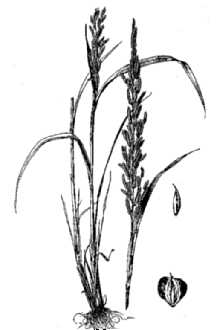American Sloughgrass
Scientific Name: Beckmannia syzigachne (Steud.) Fernald

| General Information | |
|---|---|
| Usda Symbol | BESY |
| Group | Monocot |
| Life Cycle | Annual |
| Growth Habits | Graminoid |
| Native Locations | BESY |
Plant Guide
Alternate Names
Slough grass; western sloughgrass
Uses
Beckmannia syzigachne is palatable to all classes of livestock and is frequently hayed or grazed. It frequently colonizes denuded wetland soils resulting from mud flat exposure (Walker and Coupland, 1968). Its seed units provide food for migratory water fowl. The variety ‘Egan’ was selected and released for wetland restoration and erosion control in Alaska.
Status
Please consult the PLANTS Web site and your State Department of Natural Resources for this plant’s current status and wetland indicator values.
Description
General: Grass Family (Poaceae). American sloughgrass is a cool season annual or short lived perennial grass that is commonly found in shallow marshes or sloughs. Its shallow root system supports a leafy stem, which may be as tall as one meter. Basal leaves contain cross veins that intersect the longitudinal veins at right angles to form rectangles. American sloughgrass is classified by most flora’s as an annual species. However, Wynia and Boe, (1984) stated that Beckmannia syzigachne had over wintered in several plots and nurseries at Brookings, South Dakota and was at least a short lived perennial depending on use. The branched inflorescence is classified as a closed panicle (Looman, 1983). The spikelets have very short pedicels and are arranged on only one side of the panicle branches (Reeder, 1953). Spikelets disarticulate below the glumes, and are one or two flowered (Wynia and Boe, 1983). Beckmannia syzigachne possesses the C-3 photosynthetic pathway for carbon dioxide fixation (Waller and Lewis, 1979). Distribution: For current distribution, please consult the Plant Profile page for this species on the PLANTS Web site. American sloughgrass is the North American native of a two species genus that is widespread in the cooler parts of Eurasia and North America. Beckmannia syzigachne is present in marshes and ditches throughout the northwest and north central states and is occasional in the northeast (Gould and Shaw, 1983). Habitat: In their examination of prairie, meadow and marsh vegetation in Nelson County, North Dakota, Dix and Smeins (1967) studied the drainage regimes of 100 stands selected to represent the vegetative diversity within the county. The drainage regime gradient went from excessively drained to permanent, or near-permanent gravitational water available throughout most summers. Beckmannia syzigachne was noted to occur in the three wettest regimes in combination with other species. Thus Beckmannia syzigachne is known to occur in the presence of gravitational water, either permanently or for extended periods, during the growing season.
Adaptation
American sloughgrass is adapted to conditions in the northern United States and southern Canada, Alaska and a portion of eastern Asia, Wilcox et al (1915) noted that Beckmannia was well adapted to low, irrigated, alkaline soils in western Nebraska, Chapman (1960) classified Beckmannia syzigachne as a preferential halophyte which indicated that it exhibited its best growth on saline soils, but will also grow on non-saline soils, Looman (1983) stated that it performed best on clay soils covered by a shallow layer of organic matter, Dix and Smeins (1967) found Beckmannia syzigachne grew in association with Eleocharis acicularis, Alisma triviale, Sagittaria cuneata, Glaux maritima, Polygonum coccineum, and Gratiola neglecta, Use soil moisture sensors to measure the soil moisture of American Sloughgrass.,
Establishment
Propagation of American sloughgrass via seed is the preferred method since there aren’t any dormancy restrictions that inhibit rapid and uniform germination. The planting site should be prepared and tilled to discourage weeds during the establishment period. The best planting times in the Great Plains are late fall, to allow fall establishment, or a dormant seeding, which would promote early spring establishment. The free flowing spikelets present no difficulty for conventional planting equipment. Spikelets should be planted at a depth of 7 to 15 mm deep in the soil. Richard Wynia. USDA NRCS. Beckmannia forage production plots at Brookings, SD.
Management
Beal (1896) pointed out that Beckmannia syzigachne was a forage grass of some prominence west of the Mississippi River. It is palatable to livestock (Stevens, 1963) and is frequently hayed or grazed (Clarke and Tisdale, 1945). Forage nutritional data (Clarke and Tisdale, 1945; National Academy of Science, 1971) indicated it is high in protein and nonstructural carbohydrates. Boe and Wynia (1985) found that forage and seed yields of sloughgrass ranged from 1990 to 5300 Kg/ha of forage and 440 to 620 Kg/ha of seed in an experimental planting at Brookings, South Dakota. Crude protein of 5 Beckmannia syzigachne populations harvested at early head ranged from 9.17 to 13.77 while ADF ranged from 39.15 to 44.16 (Wynia, 1987). The Egan release notice (1986) indicated that this cultivar produced seed yields of 453 and 305 pounds/acre of clean seed in 1984 and 1985, respectively. The lower yield in 1985 was the result of high winds causing seed shatter prior to harvest. Seed harvest in Alaska is generally accomplished during the second or third week in August. Mature seed was harvested in early August by Boe and Wynia (1985) at Brookings, SD. Boe consistently harvested Beckmannia syzigachne from a creek in northeast Montana in August of 1979, 1980 and 1981. Seed harvesting and processing can be accomplished with standard equipment. Seed storage in a cool, dry environment is ideal. Richard Wynia. USDA NRCS. Regrowth of Beckmannia from an established crown.
Pests and Potential Problems
Stands tend to decline after 4 or 5 years due to competition when more aggressive grass species become established in the Beckmannia syzigachne stand. Seed shatter prior to harvesting remains a moderate problem. The Alaska Plant Materials Center has found that if ‘Egan’ is grown on upland farm land without irrigation, the plants will be stressed to the point of disease onset (Wright, 1986).
Seeds and Plant Production
Plant Production
Plant Production
Boe and Evans (1981) reported that panicles of American sloughgrass bagged to prevent cross pollination exhibited 100% seed set. This would indicate that it is a self pollinated species and probably does not depend on much out crossing for sexual reproduction. The base chromosome number is X=7. All populations observed in South Dakota contained 2n=14 or 7 chromosome pairs (Wynia, 1987). This is the most commonly cited number for both Beckmannia syzigachne and Beckmannia erucaeformis (Nielsen and Humphrey, 1937; Reeder, 1953). However, there has been a report in the Russian literature of a tetraploid (2n=28) population (Zhukova and Petrovskii, 1976). Germination: Hoffman et al. (1980) reported low germination percentages for Beckmannia obtained a high of 26% from seeds that had over wintered dry and were tested under ambient April light and temperatures at Vermillion, South Dakota. Boe and Evans (1981) reported intact spikelets and caryopses freed from spikelet bracts exhibited poor germination at room temperature and disappointing emergence in greenhouse plantings. Wynia and Boe (1989) reported on germination and early seedling growth differences among populations of American sloughgrass from South Dakota(SD), Montana (MT), and Alaska (AL). Caryopses of these populations, produced simultaneously in the greenhouse under uniform conditions, were immediately subjected to 3 constant (15,20 and 25 degrees C) and 2 alternating (15-30 and 20-30 degrees C) temperature treatments during germination studies. Population AL had significantly higher percent germination at constant temperatures than did SD or MT. No significant difference in final germination was detected among populations at 15-30 degrees C. The AL population had significantly faster rates of germination and early seedling growth than the other populations at all temperatures. SD and MT populations are apparently inhibited from germination at constant temperatures even when adequate moisture was available. This germination restriction in Great Plains populations may be an adaptive trait which prevents initiation of growth during the summer months when temperatures are high and moisture tends to be erratic. Hoffman et al. (1980) indicated that darkness inhibited germination in American sloughgrass. Boe and Wynia (1985) found that darkness did not inhibit germination of Beckmannia syzigachne that was subjected to an alternating temperature regime. Plant propagation in the greenhouse may require initiating germination under alternating temperature conditions for some ecotypes. Cultivars, Improved, and Selected Materials (and area of origin) ‘Egan’ American sloughgrass was named and released as a cultivar by the Alaska Plant Materials Center at Palmer, Alaska in 1986. The original seed collection was made by James R. Stroh, July 26, 1973. The seed was harvested from a single plant growing on a gravel road fill site off Steese Highway in Gold Stream Valley, North of Fairbanks, Alaska. The name Egan was selected in honor of William A. Egan, the first and fourth Governor of the State of Alaska. Governor Egan signed into law the act creating the Alaska Plant Materials Center in 1972. Breeder and Foundation seed production will be maintained by the Alaska Plant Materials Center. Foundation class seed will be available from the Alaska Seed Growers, Inc. to seed growers for the production of Certified class seed (Alaska Plant Materials Center, 1986).
Control
Please contact your local agricultural extension specialist or county weed specialist to learn what works best in your area and how to use it safely. Always read label and safety instructions for each control method. Trade names and control measures appear in this document only to provide specific information. USDA NRCS does not guarantee or warranty the products and control methods named, and other products may be equally effective.
References
Alaska Plant Materials Center. 1986. Plant Release Notice ‘Egan’. Beal, W.J. 1896. Grasses of North America. Holt Publishing Co. New York, NY. Boe, A. and J. Evans. 1981. Spikelet characteristics and germination of American sloughgrass (Beckmannia syzigachne) (Steud.)Fern.) from northeastern Montana. Proc. S.D. Academy of Science. 60:170. Boe, A. and R. Wynia. 1985. Germination, forage yield, and seed production of American sloughgrass (Beckmannia syzigachne). Journal of
Range
Management. 38:114-116. Chapman, V.J. 1960. Salt marshes and salt deserts of the world. Plant Science Monographs. Interscience Publishers Inc. New York. Clarke, S.E. and W.E. Tisdale. 1945. The chemical composition of native forage plants of southern Alberta and Saskatchewan in relation to grazing practices. Can. Dept. of Agr. Pub. 769. Dix, R.L. and F.E. Smiens. 1967. The prairie, meadow, and marsh vegetation of Nelson County, North Dakota. Can. J. Botany. 45:21-58. Gould, F.W. and R.B. Shaw. 1983. Grass Systematics. 2nd Ed. Texas A&M, University Press. Hoffman, G.R., M.B. Hogan, and L.D. Stanley. 1980. Germination of plant species common to reservoir shores in the Northern Great Plains. Bull. Torr. Bot. Club. 107:506-513. Looman, J. 1983. 111 Range and Forage Plants of the Canadian Prairies. Res. Branch Agric. Can. Pub. 1751. Ottawa, Canada. National Academy of Science. 1971. Atlas of nutritional data on United States and Canadian feeds. Nat. Acad. Sci., Washington, D.C. Nielsen, E.L. and L.M. Humphrey. 1937. Grass studies. I. Chromosome number in certain members of the tribes Festuceae, Hordeae, Aveneae, Agrostideae, Chlorideae, Phalarideae, and Tripsaceae. Am. J. Bot. 24:276-278. Reeder, J.D. 1953. Affinities of the grass genus Beckmannia. Host. Bull. Torr. Bot. Club. 80:187-196. Stevens, O.A. 1963. Handbook of North Dakota Plants. North Dakota Inst. Environ. Studies. Fargo, North Dakota. Stewart, R.E. and H.A. Kantrud. 1971. Classificaion of natural ponds and lakes in the glaciated prairie region. U.S. Fish and Wildlife Ser. Resour. Pub. 92. Walker, B.H. and R.T. Coupland. 1968. An analysis of vegetation environmental relationships in Saskatchewan sloughs. Can. J. Bot. 46:509-522. Waller, S.S. and J.K. Lewis. 1979. Occurrence of C3 and C4 photosynthetic pathways in North American grasses. Journal of Range Man. 32:12-28. Wilcox, E.M., G.K.K. Link, and V.W. Pool. 1915. A Handbook of Nebraska Grasses. Neb. Ag. Exp. Sta. Bull. 148. Wright, Stoney. 1986. Personal Communications. Alaska Department of Natural Resources. Alaska Plant Materials Center. Wynia, R. and A. Boe. 1983. The occurrence of biflowered spikelets in Beckmannia syzigachne (Steud.)Fern. Am. J. Bot. 70(5)(2):135. Wynia R. and A. Boe. 1984. Variation in growth habit of Beckmannia syzigachne (Steud.) Fern. Proc. S.D. Acad. Sci. 63:120-121. Wynia, R. and A. Boe. 1989. Germination characteristics of Beckmannia syzigachne populations from widely separated latitudes. Society for Range Management Abst. 031. SRM Annual Meeting. Wynia, R. 1987. Agroecological studies of Beckmannia syzigachne populations. PhD Thesis. South Dakota State University. Zhukova, P.G. and V.V. Petrovskii. 1976. Chromosome numbers of some plant species of western Chukotka. Botanicheskii Zhurnal. 61 (7):963-969. Prepared By & Species Coordinator Richard L. Wynia, USDA NRCS Plant Materials Center, Manhattan, Kansas Edited: 080916jsp For more information about this and other plants, please contact your local NRCS field office or Conservation District, and visit the PLANTS Web site<http://plants.usda.gov> or the Plant Materials Program Web site <http://Plant-Materials.nrcs.usda.gov> The U.S. Department of Agriculture (USDA) prohibits discrimination in all its programs and activities on the basis of race, color, national origin, age, disability, and where applicable, sex, marital status, familial status, parental status, religion, sexual orientation, genetic information, political beliefs, reprisal, or because all or a part of an individual's income is derived from any public assistance program. (Not all prohibited bases apply to all programs.) Persons with disabilities who require alternative means for communication of program information (Braille, large print, audiotape, etc.) should contact USDA's TARGET Center at (202) 720-2600 (voice and TDD). To file a complaint of discrimination write to USDA, Director, Office of Civil Rights, 1400 Independence Avenue, S.W., Washington, D.C. 20250-9410 or call (800) 795-3272 (voice) or (202) 720-6382 (TDD). USDA is an equal opportunity provider and employer." Read about Civil Rights at the Natural Resources
Fact Sheet
Alternate Names
Slough grass
Uses
Beal indicated in 1896 that Beckmannia was a forage grass of some prominence west of the Mississippi river. Beckmannia is palatable to all classes of livestock and is frequently hayed or grazed. American sloughgrass is an important component of Alaska wetlands and provides wildlife with shelter and food. The variety ‘Egan’ was selected and released for wetland restoration and erosion control in Alaska.
Status
Please consult the PLANTS Web site and your State Department of Natural Resources for this plant’s current status (e.g. threatened or endangered species, state noxious status, and wetland indicator values).
Description and Adaptation
Adaptation , Use soil moisture sensors to measure the soil moisture of American Sloughgrass.
Adaptation
General: Grass Family (Poaceae). American sloughgrass is a cool season annual or short lived perennial grass that is commonly found in shallow marshes or sloughs. Its shallow root system supports a leafy stem, which may be as tall as a meter. The branched inflorescence is classified as a closed panicle. The spikelets have very short pedicels and are arranged on only one side of the panicle. Spikelets disarticulate below the glumes and are one or two flowered. American sloughgrass is one of two species of Beckmannia; the other Beckmannia eruciformis occurs primarily in eastern Asia. American sloughgrass is adapted to conditions in the northern United States and southern Canada, Alaska and a portion of eastern Asia.
Establishment
Gary Larson USDA NRCS Western Wetland Flora USDA NRCS Wetlands Team Propagation of American sloughgrass via seed is the preferred method since there aren’t any dormancy restrictions that inhibit rapid and uniform germination. The planting site should be prepared and tilled to discourage weeds during the establishment period. The best planting times in the Great Plains are late fall, to allow for fall establishment or a dormant seeding, which would promote early spring establishment. The free flowing spikelets present no difficulty for conventional planting equipment. Spikelets should be planted at a depth of 7 to 15 mm in the soil. There are 1,238,000 seeds of Beckmannia in a pound.
Management
Beckmannia is palatable forage for livestock and is frequently hayed or grazed. Forage nutritional data indicates that it is high in protein and nonstructural carbohydrates. Beckmannia grows wild in Alaska and the northern United States along wet meadows, marshes and swamps. It is not particular about soil type and tolerates acidic, neutral, basic and saline soil types. This species normally produces an abundance of seed, which will readily germinate upon reaching a suitable growing site. The use of Beckmannia on seasonally inundated sites where grain production is unpredictable may be feasible. Its vigorous growth habit is suited to sites where only temporary, yet productive cover is desired. Forage and seed yields under dryland conditions at Brookings, South Dakota were similar to long term averages for smooth bromegrass (Bromus inermis) in the same area. The seed unit that falls from the inflorescence at maturity is a firm, free flowing spikelet that presents no difficulties for conventional harvesting and planting equipment.
Pests and Potential Problems
Stands of American sloughgrass tend to decline after 4 or 5 years due to competition when more aggressive grass species become established in the stands. Seed shatter prior to harvesting remains a moderate problem. Processing the seed once harvested can be challenging, because the Beckmannia seed is very small and special precautions are needed to ensure that small weed seeds are not included in the final product. The Alaska Plant Materials Center has found that when ‘Egan’ is grown on upland sites without irrigation plants will be stressed to the point of disease onset. Cultivars, Improved, and Selected Materials (and area of origin) ‘Egan’ American sloughgrass was released as a cultivar by the Alaska Plant Materials Center in Palmer, Alaska in 1986 for wetland reclamation. The original seed was collected in a road fill near Fairbanks, Alaska. The cultivar ‘Egan’ was named in honor of William A. Egan, the first and fourth Governor of the State of Alaska. Breeder and Foundation Class seed production will be maintained by the Alaska Plant Materials Center. Registered and Certified class seeds will be available from Alaska Seed Growers, Inc.
Plant Traits
Growth Requirements
| Temperature, Minimum (°F) | -33 |
|---|---|
| Adapted to Coarse Textured Soils | No |
| Adapted to Fine Textured Soils | Yes |
| Adapted to Medium Textured Soils | Yes |
| Anaerobic Tolerance | High |
| CaCO3 Tolerance | Low |
| Cold Stratification Required | No |
| Drought Tolerance | None |
| Fertility Requirement | Medium |
| Fire Tolerance | High |
| Frost Free Days, Minimum | 100 |
| Hedge Tolerance | None |
| Moisture Use | High |
| pH, Maximum | 7.5 |
| pH, Minimum | 5.5 |
| Precipitation, Maximum | 60 |
| Precipitation, Minimum | 30 |
| Root Depth, Minimum (inches) | 16 |
| Salinity Tolerance | Medium |
| Shade Tolerance | Intermediate |
Morphology/Physiology
| After Harvest Regrowth Rate | Slow |
|---|---|
| Toxicity | None |
| Shape and Orientation | Erect |
| Nitrogen Fixation | None |
| Resprout Ability | No |
| Active Growth Period | Spring and Summer |
| Bloat | None |
| C:N Ratio | Medium |
| Coppice Potential | No |
| Fall Conspicuous | No |
| Fire Resistant | No |
| Flower Color | Yellow |
| Flower Conspicuous | No |
| Foliage Color | Green |
| Foliage Porosity Summer | Moderate |
| Foliage Texture | Medium |
| Fruit/Seed Color | Brown |
| Fruit/Seed Conspicuous | No |
| Growth Form | Bunch |
| Growth Rate | Moderate |
| Height, Mature (feet) | 3.0 |
| Known Allelopath | No |
| Leaf Retention | No |
| Low Growing Grass | Yes |
| Foliage Porosity Winter | Porous |
Reproduction
| Propagated by Seed | Yes |
|---|---|
| Propagated by Sod | No |
| Propagated by Sprigs | No |
| Propagated by Tubers | No |
| Fruit/Seed Persistence | No |
| Seed per Pound | 238000 |
| Seed Spread Rate | Moderate |
| Seedling Vigor | High |
| Small Grain | No |
| Vegetative Spread Rate | None |
| Propagated by Corm | No |
| Propagated by Container | No |
| Propagated by Bulb | No |
| Propagated by Bare Root | No |
| Fruit/Seed Period End | Summer |
| Fruit/Seed Period Begin | Spring |
| Fruit/Seed Abundance | High |
| Commercial Availability | Routinely Available |
| Bloom Period | Mid Spring |
| Propagated by Cuttings | No |
Suitability/Use
| Veneer Product | No |
|---|---|
| Pulpwood Product | No |
| Protein Potential | Low |
| Post Product | No |
| Palatable Human | No |
| Palatable Graze Animal | Low |
| Palatable Browse Animal | Medium |
| Nursery Stock Product | No |
| Naval Store Product | No |
| Lumber Product | No |
| Fodder Product | No |
| Christmas Tree Product | No |
| Berry/Nut/Seed Product | No |

